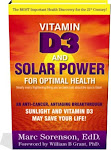Cardiovascular diseases (CVD) such as heart disease and stroke are the number-one killers of both men and women. Can ultraviolet light B (UVB) and vitamin D prevent CVD and save your life?
Cancer is a word that strikes fear into the heart of every American, and in the wake of the Creighton University study showing that vitamin D supplementation reduced the risk of cancer by 60-77%,(1) many pharmacies and supplement stores, especially in Canada, sold out of vitamin D.
Lost in the enthusiasm for this study, however, were others that assessed the influence of blood vitamin D levels on heart disease—a disease that kills more Americans than all cancers combined. In one study, selected risk factors for heart disease were compared with vitamin D levels in the blood. The risk factors measured were hypertension, diabetes, obesity, and triglyceride levels. When those with the lowest vitamin D levels were compared to those with the highest levels, hypertension was 30% higher, diabetes 98% higher, obesity 129% higher and triglycerides 47% higher.(2)
Indeed, there are already other indications that UVB and vitamin D reduce the risk of CVD. Consider the following:
Vitamin D reduces arterial calcification. Low levels of vitamin D lead to calcification of the arteries, one of the major causes of arterial plaque that leads to CVD and heart attacks.(4) When vitamin D levels are low, parathyroid hormone (PTH) becomes high, which leads to calcification of arteries.(7) PTH levels are much lower in those who use tanning beds, and vitamin D levels are also optimized in persons who use tanning beds.(8)
UVB and vitamin D reduce hypertension. Hypertension (high blood pressure) is a well-known risk factor for both heart attack and stroke. Men with the lowest vitamin D levels have 6.13 times the risk of hypertension as men with the lowest levels. Women with the lowest levels have 2.67 times the risk.(5) Exposure to UV that increases blood levels of vitamin D to 40 ng/ml (80 nmol/l) has also been shown to reduce hypertension.(12) In three sessions per week of full-body UVB light treatments, carried on for six weeks, vitamin D levels rose 162%, and average blood pressures dropped six points on both systolic (higher number) and diastolic (lower number) measurements.
UVB diminishes the risk of heart failure. In a study done is Spain, it was found that hospital admissions for heart failure were 25% higher than average in January and 33% lower in August. That is a 58% swing between winter and summer!(6) This indicates that UVB is exceptionally important in reducing the incidence of heart failure, and that UVB from a tanning bed would be the perfect therapy to prevent the excess of winter heart failure.
Vitamin D inhibits arterial inflammation. Arterial inflammation is a major risk factor for CVD. High levels of an inflammatory protein called C-reactive protein (CRP) are considered very important predictors of heart disease. Vitamin D supplements can lower CRP levels as much as 40%.(9) Inflammation can also be caused by proteins called cytokines that work as part of the immune system.(10) These proteins are either pro-inflammatory or anti-inflammatory. Vitamin D has the amazing ability to inhibit pro-inflammatory cytokine production10 while stimulating production of anti-inflammatory cytokines.(11) Vitamin D is truly a miracle hormone, and the most efficient manner of stimulating its production is through tanning-bed use.
So, when it comes to matters of the heart, it behooves us not only to eat correctly, but to protect ourselves by keeping vitamin D levels high through non-burning exposure to UVB, and when UVB is not available, to supplement with vitamin D3. For those adults who do not have a source of UVB light, 2,000 international units daily is essential.
References:
1. Lappe, J. et al. Vitamin D and calcium supplementation reduces cancer risk: results of a randomized trial. Am J Clin Nutr 2007;85:1586-91.
2. Martins, D. et al. Prevalence of Cardiovascular Risk Factors and the Serum Levels of 25-Hydroxyvitamin D in the United States. Data from the Third National Health and Nutrition Examination Survey Arch Intern Med 2007;167:1159-1165.
3. Scragg, R. et al. Myocardial infarction is inversely associated with plasma 25-hydroxyvitamin D3 levels: a community-based study. Int J Epidemiol 1990;3:559-63.
4. Zitterman, A. Vitamin D and arterial calcification. Curr Opin Lipidol 2007;18:41-46.
5. Forman, J. et al. Plasma 25-Hydroxyvitamin D Levels and Risk of Incident hypertension. Hypertension 2007;49:1063-9.
6. Martinez-Selles, M. et al. Annual rates of admission and seasonal variations in hospitalizations for heart failure. Eur J Heart Fail 2002;4:779-86.
7. Rostand, S. et al. Parathyroid hormone, vitamin D, and cardiovascular disease in chronic renal failure. Kidney Int 1999;56:383-92.
8. Tangpricha, V. et al. Tanning is associated with optimal vitamin D status (serum 25-hydroxyvitamin D concentration) and higher bone mineral density. Am J Clin Nutr 2004;80:1645-49.
9. Zittermann, A. et al. Putting cardiovascular disease and vitamin D insufficiency into perspective. Br J Nutr 2005;94:483-92.
10. Muller, K. et al. 1,25-Dihydroxyvitamin D3 inhibits cytokine production by human blood monocytes at the post-transcriptional level. Cytokine 1992;4:506-12.
11. Canning, M. et al. I-alpha,25-Dihydroxyvitamin D3 (l,25(OH)(2)D(3)) hampers the maturation of fully active immature dendritic cells from monocytes. Eur J Endocrinol 2001;145:351-57.
12. Krause, R. et al. Ultraviolet B and blood pressure. Lancet 1998;352:709-10.
13. Wang, T. et al. Vitamin D deficiency and risk of cardiovascular disease. Circulation 2008;117 pre-publication copy.

